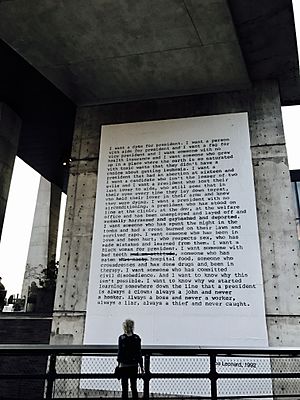Zoe Leonard facts for kids
Zoe Leonard (born 1961) is an American artist. She mainly creates art using photography and sculpture. Her work has been shown in many important art shows since the late 1980s. These include Documenta IX and Documenta XII, and the Whitney biennials in 1993, 1997, and 2014. She received a Guggenheim Fellowship in 2020.
Contents
Early Life and Art Beginnings
Zoe Leonard was born in 1961 in Liberty, New York. Her mother was a refugee from Poland who came to America during World War II. Her family faced hard times during the war.
When Zoe was 16, she left school and started taking photos. She has lived most of her life in New York City. The city's buildings and streets, like sidewalks and fences, often appear in her art. She became famous around the world after her art was shown at Documenta IX in 1992.
Exploring Art and Ideas
Zoe Leonard's art often makes us think about how we see things. She looks at how images are framed and organized. She once said she is interested in how we look at the world and how our own views shape what we experience.

In the 1980s and 1990s, Leonard was active in groups that supported people with AIDS and fought for equal rights. In 1992, she wrote a famous poem called "I want a president." This poem was inspired by a friend who ran for president. In 2016, a large picture of the poem was put up on the High Line in New York City.
Strange Fruit Sculpture
Leonard's sculptures show her amazing attention to detail. One of her most powerful works is "Strange Fruit." It is made of 300 fruit skins that she carefully stitched back together. This artwork helps us remember people who were lost and think about sadness.
In 1995, she showed "Strange Fruit" in her studio. She had saved fruit skins (like oranges and bananas) and sewn them with wire and thread. "Strange Fruit" is dedicated to her friend, artist David Wojnarowicz, who passed away in 1992. This artwork became very important in the 1990s as a way to think about loss during the AIDS epidemic. It is now at the Philadelphia Museum of Art.
Art Inspired by Nature
In the mid-1990s, Leonard lived and worked in Eagle, Alaska for two years. This experience greatly influenced her later art. Many of her works explore the connection between people and nature. In Alaska, she worked on a farm and for the National Park Service. She created a photo series called Hunting about how people live off the land.
Trees are also a common theme in Leonard's art. For example, she created a "reconstructed" tree for an art show in Vienna. She also took many photos of city trees tangled in fences.
Fae Richards Photo Archive
In 1993, director Cheryl Dunye asked Leonard to create fake old photographs for her movie, The Watermelon Woman. In the film, the main character looks for the history of a Black lesbian entertainer named Fae Richards. Leonard treated the photos by hand to make them look old. These photos were used in the movie and shown at the 1997 Whitney Biennial.
Analogue Project
From 1998 to 2009, Leonard worked on a huge project called Analogue. It includes 412 prints and a collection of 40 special prints. This project looks at how global trade and relationships have changed. It also explores the shift from old-style film photography to digital cameras.
A writer for The New York Times described how Analogue shows a city's culture disappearing. Many cheap goods sold in New York shops came from factories in China and Pakistan. These goods are then sent to poorer cities in Africa and Central America. In Analogue, you can see recycled clothes traveling from Brooklyn to Kampala, Uganda.
Art Shows and Recognition
Analogue was first shown in 2007 at the Wexner Center for the Arts and at Documenta XII. It then traveled to other places like the Museum of Modern Art in New York. This work is now part of the collections at The Museum of Modern Art and the Reina Sofia Museum.
More recently, Leonard's exhibitions include You See I Am Here After All at Dia: Beacon (2009). This show featured 3883 postcards of waterfalls, mostly Niagara Falls. Another exhibition was at the Chinati Foundation (2013-2014). In 2014, she won the Bucksbaum Award at the Whitney Biennial for her work "945 Madison Avenue."
In 2018, the Whitney Museum of American Art held Leonard's first big show in the United States. This show then traveled to the Museum of Contemporary Art, Los Angeles.
Other Activities
Zoe Leonard is also a thoughtful writer about photography. Her writings have appeared in various art magazines.
Since 2018, Leonard has been on the advisory board of the Hauser & Wirth Institute. She also helped choose the winner of the first Maria Lassnig Prize in 2017. She works from her studio in the Brooklyn Navy Yard.
Leonard has taught at Bard College. She was also the co-chair of the photography department at the Milton Avery Graduate School of the Arts from 2011 to 2015.
Awards and Honors
Zoe Leonard has received several important awards. She was given the Bucksbaum Prize in 2014 by the Whitney Museum. In 2005, she received the Anonymous was a Woman Award. She also earned a Guggenheim Fellowship in 2020.
See also
 In Spanish: Zoe Leonard para niños
In Spanish: Zoe Leonard para niños



